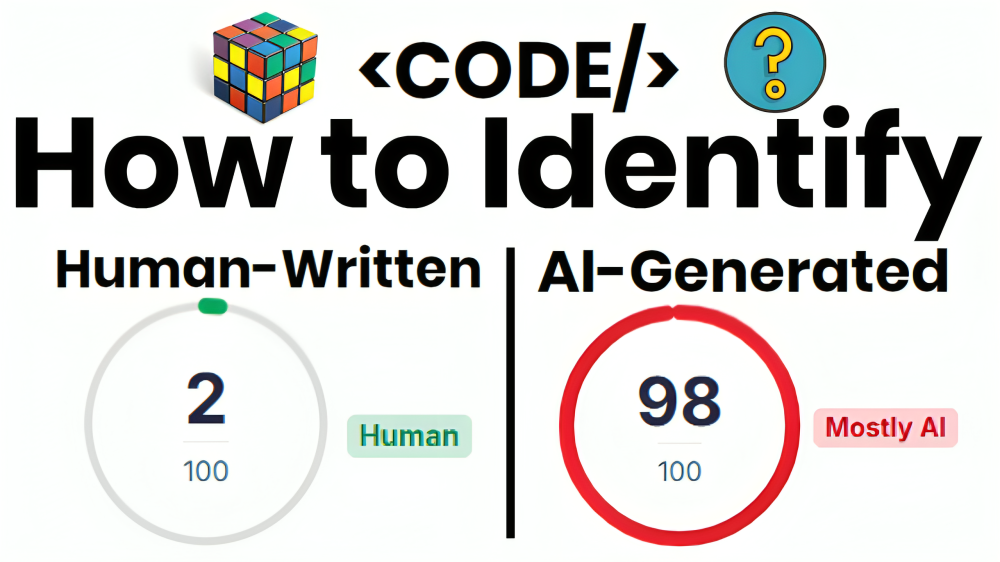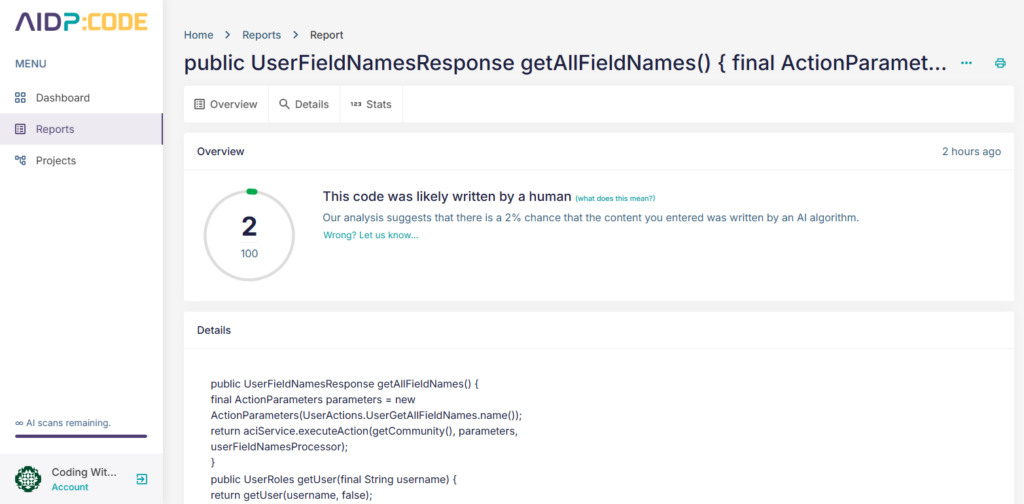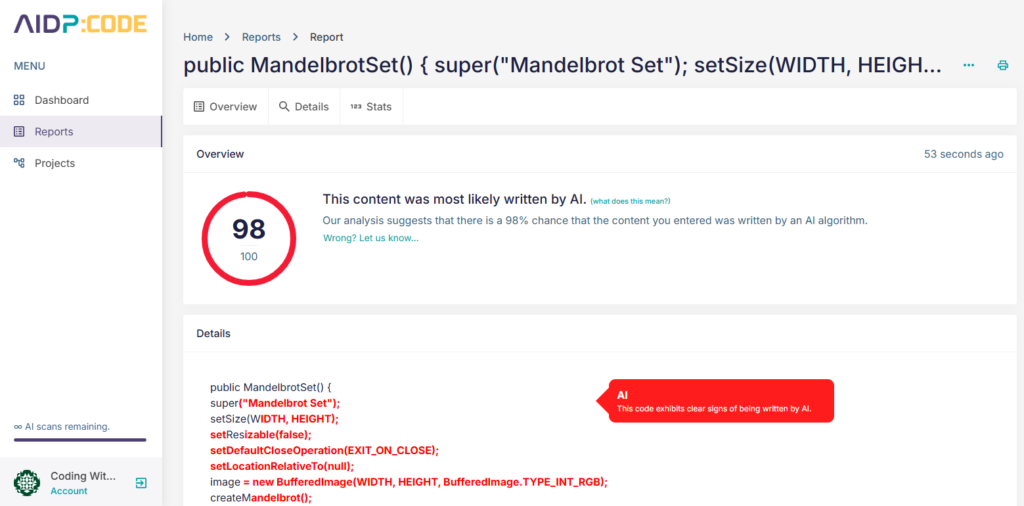
In today’s tech-driven world, artificial intelligence (AI) has become a powerful ally for developers, offering tools that generate code in seconds. While these tools can save time and effort, they also present unique challenges. AI-generated code may contain hidden bugs, inefficiencies, or ethical concerns that could lead to significant problems down the line. This is where Code.AIDetector.pro comes into play—helping developers, teams, and businesses distinguish between AI-generated and human-written code with precision and efficiency.
Why Understanding the Source of Code Matters
The ability to differentiate AI-generated code from human-written code is more than just a technical curiosity; it’s essential for maintaining accountability, quality, and trust in software development. Here’s why:
- Accountability:
When you know whether a piece of code is AI-generated or manually written, it becomes easier to hold developers accountable for its quality. Teams can ensure that any issues or bugs are addressed promptly and that the code meets industry standards. - Debugging and Quality Assurance (QA):
AI-generated code often follows learned patterns, which means it might not account for unique project requirements or edge cases. Identifying these sections allows QA teams to focus their testing efforts on areas more likely to contain issues. - Client Trust:
Clients want assurance that the software they receive is reliable and free of unnecessary vulnerabilities. Highlighting AI-generated sections of code provides transparency and fosters trust between developers and their clients.
Human vs. AI-Generated Code: Key Differences
While AI has become adept at writing code, there are significant differences between code generated by humans and code generated by machines:
- Creativity and Contextual Understanding:
Human developers bring creativity and a deep understanding of the project’s goals, writing solutions tailored to specific needs. AI, on the other hand, operates within predefined patterns and may lack the contextual nuance to address unique challenges. - Error Handling and Edge Cases:
Humans anticipate and code for edge cases, ensuring robustness under various conditions. AI-generated code may miss these critical details, leading to potential failures. - Ethics and Standards:
Humans are better equipped to write code that aligns with ethical guidelines and industry standards, whereas AI might inadvertently produce solutions that conflict with these principles.
How Code.AIDetector.pro Helps
Code.AIDetector.pro is a cutting-edge tool designed to bridge the gap between the benefits of AI coding and the need for high-quality, human-reviewed software. Here’s how it works and why it’s essential:
- Efficient Scanning:
The tool automatically scans an entire codebase and pinpoints sections likely generated by AI, saving developers from the tedious task of reviewing every line. - Targeted Debugging:
By flagging AI-generated sections, the tool allows developers and QA teams to focus their attention where it’s needed most. This improves efficiency and ensures that the riskiest parts of the code are thoroughly tested. - Time-Saving:
For teams working under tight deadlines, Code.AIDetector.pro reduces the time spent on manual reviews, enabling faster project delivery without compromising on quality. - Supports Multiple Languages:
The tool works seamlessly with popular programming languages like Java, C#, Python, JavaScript, and PHP, making it versatile for various projects.
Who Can Benefit from This Tool?
Code.AIDetector.pro is ideal for:
- Independent Software Consultants:
They can detect buggy AI-generated code, fix issues before client delivery, and maintain a reputation for high-quality work. - Freelance Developers:
Freelancers often rely on AI tools to meet deadlines. This tool helps them maintain accountability and deliver polished projects with fewer revisions. - Small Business Teams:
Small teams with limited resources can use this tool to streamline quality assurance and ensure AI-generated code meets their standards. - Quality Assurance (QA) Engineers:
QA teams can focus their testing efforts on flagged sections, improving efficiency and reducing overall testing time. - Engineering Managers:
Managers overseeing teams using AI tools can ensure accountability and maintain consistent coding standards across projects.
A Simple Example
Imagine you’re a client who hires two developers for a project:
- Developer A writes code manually based on your requirements.
- Developer B uses AI to generate most of the code.
Once the project is complete, you need to ensure the code is reliable and bug-free. Instead of reviewing every line of code, you use Code.AIDetector.pro to scan the project. The tool flags sections generated by AI, allowing you to focus your attention on areas more likely to have issues. This saves time, ensures quality, and builds trust in the development process.
Human Written – Java Code

public UserFieldNamesResponse getAllFieldNames() {
final ActionParameters parameters = new
ActionParameters(UserActions.UserGetAllFieldNames.name());
return aciService.executeAction(getCommunity(), parameters,
userFieldNamesProcessor);
}
public UserRoles getUser(final String username) {
return getUser(username, false);
}
public User getUserDetails(final String username) {
return getUserDetails(username, false);
}
public User getUserDetails(final Long uid) {
final ActionParameters parameters = new
ActionParameters(UserActions.UserRead.name());
parameters.add(UserReadParams.UID.name(), uid);
parameters.add(UserReadParams.SecurityInfo.name(), true);
parameters.add(UserReadParams.DeferLogin.name(), false);
parameters.add(UserReadParams.RoleList.name(), true);
parameters.add(UserReadParams.Recurse.name(), true);
return aciService.executeAction(getCommunity(), parameters,
userProcessor);
}
public long addUser(final String username, final String password) {
final ActionParameters parameters = new
ActionParameters(UserActions.UserAdd.name());
parameters.add(UserAddParams.UserName.name(), username);
parameters.add(UserAddParams.Password.name(), password);
return aciService.executeAction(getCommunity(), parameters,
uidProcessor).getUid();
}
public void deleteUser(final long uid) {
final ActionParameters parameters = new
ActionParameters(UserActions.UserDelete.name());
parameters.add(UserDeleteParams.UID.name(), uid);
aciService.executeAction(getCommunity(), parameters, emptyProcessor);
}
public void deleteUser(final String username) {
final ActionParameters parameters = new
ActionParameters(UserActions.UserDelete.name());
parameters.add(UserDeleteParams.UserName.name(), username);
aciService.executeAction(getCommunity(), parameters, emptyProcessor);
}
public void resetPassword(final long uid, final String password) {
final ActionParameters parameters = new
ActionParameters(UserActions.UserEdit.name());
parameters.add(UserEditParams.UID.name(), uid);
parameters.add(UserEditParams.ResetPassword.name(), true);
parameters.add(UserEditParams.NewPassword.name(), password);
aciService.executeAction(getCommunity(), parameters, emptyProcessor);
}
public void resetPassword(final String username, final String password) {
final ActionParameters parameters = new
ActionParameters(UserActions.UserEdit.name());
parameters.add(UserEditParams.UserName.name(), username);
parameters.add(UserEditParams.ResetPassword.name(), true);
parameters.add(UserEditParams.NewPassword.name(), password);
aciService.executeAction(getCommunity(), parameters, emptyProcessor);
}
public void addRole(final String role) {
final ActionParameters parameters = new
ActionParameters(RoleActions.RoleAdd.name());
parameters.add(RoleAddParams.RoleName.name(), role);
aciService.executeAction(getCommunity(), parameters, emptyProcessor);
}
public void addUserToRole(final long uid, final String role) {
final ActionParameters parameters = new
ActionParameters(RoleActions.RoleAddUserToRole.name());
parameters.add(RoleAddUserToRoleParams.RoleName.name(), role);
parameters.add(RoleAddUserToRoleParams.UID.name(), uid);
aciService.executeAction(getCommunity(), parameters, emptyProcessor);
}
public void addUserToRole(final String username, final String role) {
final ActionParameters parameters = new
ActionParameters(RoleActions.RoleAddUserToRole.name());
parameters.add(RoleAddUserToRoleParams.RoleName.name(), role);
parameters.add(RoleAddUserToRoleParams.UserName.name(), username);
aciService.executeAction(getCommunity(), parameters, emptyProcessor);
}
public void removeUserFromRole(final long uid, final String role) {
final ActionParameters parameters = new
ActionParameters(RoleActions.RoleRemoveUserFromRole.name());
parameters.add(RoleRemoveUserFromRoleParams.RoleName.name(), role);
parameters.add(RoleRemoveUserFromRoleParams.UID.name(), uid);
aciService.executeAction(getCommunity(), parameters, emptyProcessor);
}
public void removeRole(final String role) {
final ActionParameters parameters = new
ActionParameters(RoleActions.RoleDelete.name());
parameters.add(RoleDeleteParams.RoleName.name(), role);
aciService.executeAction(getCommunity(), parameters, emptyProcessor);
}
public Profiles profileRead(final String user) {
final ActionParameters parameters = new
ActionParameters("ProfileRead");
parameters.put("Username", user);
parameters.put("ShowTerms", true);
parameters.put("ShowInfo", true);
return aciService.executeAction(getCommunity(), parameters,
profiles Processor);
}
private AciServerDetails getCommunity() {
return userAdminConfig.getConfig().getCommunityDetails();
}
private AciServerDetails getAgentStore() {
return userAdminConfig.getConfig().getCommunityAgentStoreDetails();
}AI Generated – Java Code

public MandelbrotSet() {
super("Mandelbrot Set");
setSize(WIDTH, HEIGHT);
setResizable(false);
setDefaultCloseOperation(EXIT_ON_CLOSE);
setLocationRelativeTo(null);
image = new BufferedImage(WIDTH, HEIGHT, BufferedImage.TYPE_INT_RGB);
createMandelbrot();
}
private void createMandelbrot() {
for (int x = 0; x < WIDTH; x++) {
for (int y = 0; y < HEIGHT; y++) {
double zx = 0;
double zy = 0;
double cX = (x - WIDTH / 2.0) / ZOOM;
double cY = (y - HEIGHT / 2.0) / ZOOM;
int iter = MAX_ITER;
while (zx * zx + zy * zy < 4 && iter > 0) {
double tmp = zx * zx - zy * zy + cX;
zy = 2.0 * zx * zy + cY;
zx = tmp;
iter--;
}
// Choose a color based on the number of iterations
image.setRGB(x, y, iter | (iter << 8));
}
}
}
public void paint(Graphics g) {
g.drawImage(image, 0, 0, this);
}
public static void main(String[] args) {
SwingUtilities.invokeLater(() -> {
MandelbrotSet mandelbrot = new MandelbrotSet();
mandelbrot.setVisible(true);
});
}Why This Tool Is Essential in an AI-Driven World
As AI continues to play a larger role in software development, tools like Code.AIDetector.pro are becoming indispensable. They strike a balance between leveraging AI for efficiency and maintaining the high standards of human oversight. By identifying AI-generated code, developers can focus on improving its quality, ensuring that the final product meets both technical and ethical standards.
Conclusion
In a world where AI and human expertise coexist in the software development process, tools like Code.AIDetector.pro are game-changers. They empower developers to harness the power of AI while ensuring accountability, quality, and trust. Whether you’re an independent consultant, a small business, or part of a QA team, this tool helps you save time, improve workflows, and deliver better software.
Are you ready to transform your coding process? Try Code.AIDetector.pro today and take your development to the next level!
